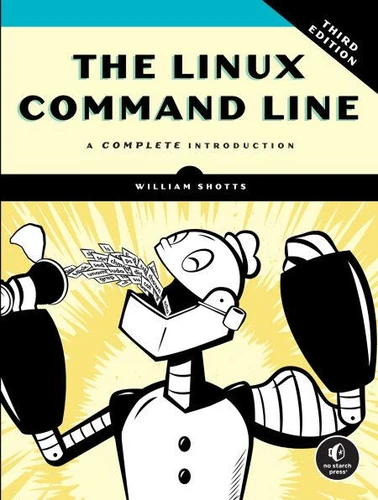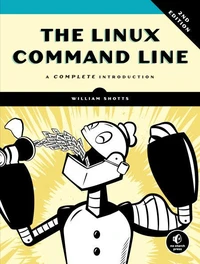The Linux Command Line, 3rd Edition. A Complete Introduction
Par :Formats :
Actuellement indisponible
Cet article est actuellement indisponible, il ne peut pas être commandé sur notre site pour le moment. Nous vous invitons à vous inscrire à l'alerte disponibilité, vous recevrez un e-mail dès que cet ouvrage sera à nouveau disponible.
Disponible dans votre compte client Decitre ou Furet du Nord dès validation de votre commande. Le format ePub est :
- Compatible avec une lecture sur My Vivlio (smartphone, tablette, ordinateur)
- Compatible avec une lecture sur liseuses Vivlio
- Pour les liseuses autres que Vivlio, vous devez utiliser le logiciel Adobe Digital Edition. Non compatible avec la lecture sur les liseuses Kindle, Remarkable et Sony
 , qui est-ce ?
, qui est-ce ?Notre partenaire de plateforme de lecture numérique où vous retrouverez l'ensemble de vos ebooks gratuitement
Pour en savoir plus sur nos ebooks, consultez notre aide en ligne ici
- Nombre de pages504
- FormatePub
- ISBN978-1-7185-0453-0
- EAN9781718504530
- Date de parution03/02/2026
- Protection num.pas de protection
- Infos supplémentairesepub
- ÉditeurNo Starch Press
Résumé
You've experienced the shiny, point-and-click surface of your Linux computer-now dive below and explore its depths with the power of the command line. The Linux Command Line takes you from your very first terminal keystrokes to writing full programs in Bash, the most popular Linux shell (or command line). Along the way you'll learn the timeless skills handed down by generations of experienced, mouse-shunning gurus: file navigation, environment configuration, command chaining, pattern matching with regular expressions, and more.
In addition to that practical knowledge, author William Shotts reveals the philosophy behind these tools and the rich heritage that your desktop Linux machine has inherited from Unix supercomputers of yore. As you make your way through the book's short, easily-digestible chapters, you'll learn how to: Create and delete files, directories, and symlinks Administer your system, including networking, package installation, and process management Use standard input and output, redirection, and pipelines Edit files with Vi, the world's most popular text editor Write shell scripts to automate common or boring tasks Slice and dice text files with cut, paste, grep, patch, and sed Once you overcome your initial "shell shock, " you'll find that the command line is a natural and expressive way to communicate with your computer.
Just don't be surprised if your mouse starts to gather dust.
In addition to that practical knowledge, author William Shotts reveals the philosophy behind these tools and the rich heritage that your desktop Linux machine has inherited from Unix supercomputers of yore. As you make your way through the book's short, easily-digestible chapters, you'll learn how to: Create and delete files, directories, and symlinks Administer your system, including networking, package installation, and process management Use standard input and output, redirection, and pipelines Edit files with Vi, the world's most popular text editor Write shell scripts to automate common or boring tasks Slice and dice text files with cut, paste, grep, patch, and sed Once you overcome your initial "shell shock, " you'll find that the command line is a natural and expressive way to communicate with your computer.
Just don't be surprised if your mouse starts to gather dust.
You've experienced the shiny, point-and-click surface of your Linux computer-now dive below and explore its depths with the power of the command line. The Linux Command Line takes you from your very first terminal keystrokes to writing full programs in Bash, the most popular Linux shell (or command line). Along the way you'll learn the timeless skills handed down by generations of experienced, mouse-shunning gurus: file navigation, environment configuration, command chaining, pattern matching with regular expressions, and more.
In addition to that practical knowledge, author William Shotts reveals the philosophy behind these tools and the rich heritage that your desktop Linux machine has inherited from Unix supercomputers of yore. As you make your way through the book's short, easily-digestible chapters, you'll learn how to: Create and delete files, directories, and symlinks Administer your system, including networking, package installation, and process management Use standard input and output, redirection, and pipelines Edit files with Vi, the world's most popular text editor Write shell scripts to automate common or boring tasks Slice and dice text files with cut, paste, grep, patch, and sed Once you overcome your initial "shell shock, " you'll find that the command line is a natural and expressive way to communicate with your computer.
Just don't be surprised if your mouse starts to gather dust.
In addition to that practical knowledge, author William Shotts reveals the philosophy behind these tools and the rich heritage that your desktop Linux machine has inherited from Unix supercomputers of yore. As you make your way through the book's short, easily-digestible chapters, you'll learn how to: Create and delete files, directories, and symlinks Administer your system, including networking, package installation, and process management Use standard input and output, redirection, and pipelines Edit files with Vi, the world's most popular text editor Write shell scripts to automate common or boring tasks Slice and dice text files with cut, paste, grep, patch, and sed Once you overcome your initial "shell shock, " you'll find that the command line is a natural and expressive way to communicate with your computer.
Just don't be surprised if your mouse starts to gather dust.




